Is your digital marketing strategy focused only on top of funnel expansion? How do you move from increasing awareness to increased conversions? Have you considered remarketing? At (un)Common Logic, our expert B2B SaaS marketing services, including retargeting strategies, grew one of our B2B SaaS client’s conversion rate by 288%, conversion volume by 828%, and reduced cost per lead by 67% in three months. On average, 79% of marketing leads don’t convert into sales due to lack of nurturing processes. Remember, it’s not only about increasing awareness, but also the attention you give your audience once they’re aware of your business and offerings.
Once you’ve decided to include remarketing, you need to consider:
- Which platform(s) to use
- How to track your audience so you can remarket to the right prospects
- What list(s) you want to use for remarketing purposes
Keep reading for (un)Common Logic’s tips and tricks for creating a successful remarketing campaign.
What is the Purpose of Remarketing?
Before we can deep-dive into strategy, we must break down the remarketing basics and why it is so important.
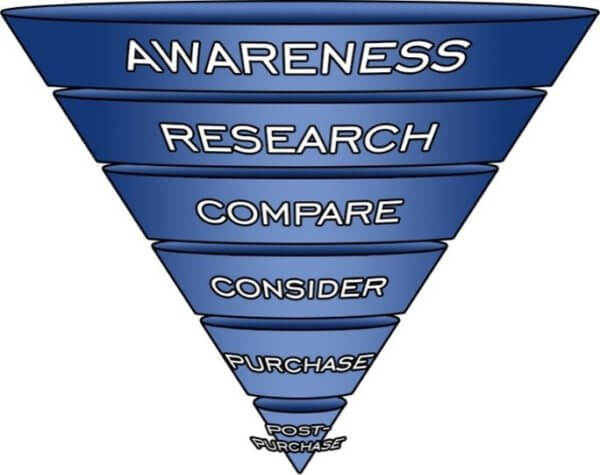
Let’s take a look at your basic marketing funnel. The awareness stage is crucial for brand recognition and expansion, but does not guarantee a conversion, especially if you’re in a competitive space. Think of window shopping: you see a jacket in a store with a cool logo, but you don’t currently need a jacket, so you walk away (awareness). Then, as you’re driving around, you see a billboard with the same jacket worn by a celebrity at a discounted price (research), so now you might think about going back to buy the jacket. When heading back to the store, you pass by a similar jacket but with a different logo (compare), but you still want to check out the original store before you buy a jacket. Finally, you get back to the original shop and see that discount sign again making it cheaper than the other jacket (consider), this ultimately makes you buy the jacket (purchase).
The billboard, the celebrity, and the discount were all remarketing tactics that succeeded in pushing a purchase. Remarketing is one of the best ways to close sales that didn’t happen the first time.
What is Required for Successful Remarketing Campaigns?
A solid foundation for the best remarketing strategy requires proper tag installation and a strong customer match list. Keep reading to learn more about requirements and parameters for tags and lists.
What Platforms Can Utilize Remarketing/Retargeting?
Google and Facebook (Meta) are the most used platforms for remarketing ads due to their ease in implementation and diversity in applications.
How Do You Implement Remarketing in Google Ads?
Tag-You’re-It
Determine what landing pages are directly related to your marketing objectives, for example, the landing page(s) could be a dedicated PPC landing page or white paper. These are the pages you would want to set up your ad campaign around.
It is crucial that your remarketing tag is installed correctly on all website pages to ensure that the right visitor traffic is being captured to strengthen your remarketing campaign. To create a Google Ads Remarketing Tag, you will first need to have Google Tag Manager (GTM) account set up. After that is completed, follow these steps to set up a Google Ads Remarketing Tag. This Google developer guide has instructions on how to set up remarketing tags in Google Analytics.
Is there a benefit to using one or the other? The answer is dependent on the data needs of the account. If you’re looking to go in-depth with specific website conversion actions, such as video views or website bounce rate and user traffic, we would recommend installing Google Analytics’ remarketing tag. However, if you are looking to retarget one audience group, we would recommend Google Ads’ remarketing tag.
Using a First Party Customer Match List to Remarket in Google
A remarketing list is a list made up of customer emails in addition to customers’ first and last names. Google search network and display requires a 1000+ audience list to be big enough to serve ads. When you upload your list to Google Ads, the system will flag if the list is large enough to use. This process should take about 1 – 24 hours to scan depending on the size.
How Do You Implement Remarketing in Facebook Ads?
To set up your Facebook (Meta) remarketing ads, leverage Facebook’s (Meta’s) retargeting pixel and your remarketing lists.
Pixel Perfect
Similar to Google, Facebook (Meta) has a code that you or your website developer can install on your website. This tag tracks users’ engagement with your brand’s Facebook ads and website through clicks, add to carts, or pageviews. After this tag is set up, Facebook (Meta) will begin building your “lookalike” audiences – audiences who have similar interests or behaviors as your current website visitors – and can also dynamically serve ads to those who already visited your website.
Don’t Forget Those Minimums
Prepare a list of at least 100 people to target on Facebook (Meta). Again, this list can come from a variety of sources: newsletter sign-ups, sweepstake sign-ups, or whitepaper downloads. According to Facebook, this list will be secure and will NOT be shared with other businesses unless you grant access.
Strategies and Tactics for Effective Remarketing
Now that we’ve gone over the basic set ups and functionality, let’s deep-dive into the details for the best remarketing strategies.
1. Remarketing lists can be built from almost anything.
Did you have a recent giveaway? Did you have a newsletter or whitepaper download? Did you have a slew of purchasers? Did you have a virtual webinar? Remarketing lists can be made from all the above – as long as you have the visitors’ email, first and last name, that’s all you need. Depending on your needs, (un)Common Logic recommends retargeting audiences that have completed lower funnel actions such as PDF downloads on a specific page. This ensures higher quality conversions versus those who only complete email form fills from a pop-up or newsletter. Just make sure that you abide by the user minimums listed in the previous sections.
2. Be intentional. Retarget specific URL visits to guarantee quality.
Website visitors are great but can be a hit or a miss depending on the type of traffic you were getting on your website. For example, if you target very broad affinity audiences on Google and you retarget just site visitors, you might be wasting ad spend on users that are not very interested in your services. However, if you target high intent pages such as video demos (get granular and target 7% video watched) or case study pages, this ensures that your remarketing ads are being served to a relevant audience. We’ve developed successful B2B remarketing campaigns that target previous webinar attendees and PDF downloaders. Our cybersecurity client had a 185% higher conversion rate and a 20% lower bounce rate with returning visitors than new visitors.
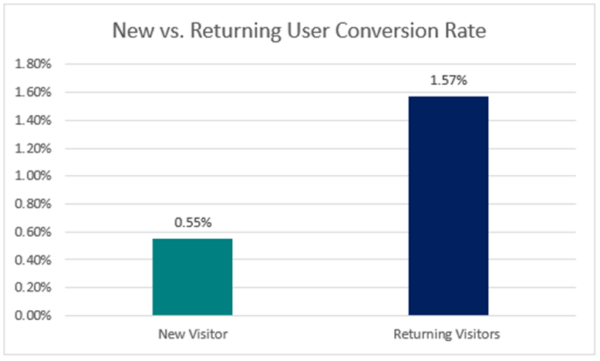
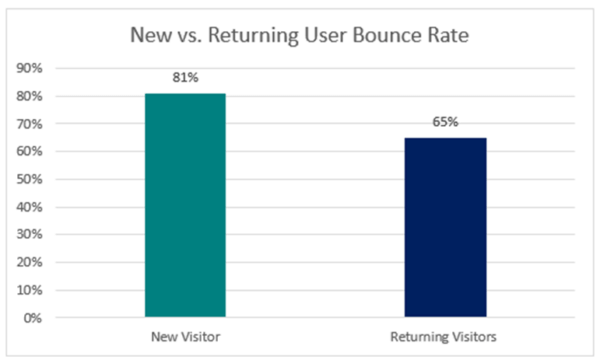
3. Abandoned Carts? Don’t be discouraged!
If your product has a long buying cycle, remarketing ads are your secret weapon. Make sure that these folks are being targeted for upcoming promotions or new launches. They clearly have displayed interest in your product but just need that final push to complete a purchase.
4. You’ve correctly tagged everything and grown your lists, great, but that’s not all!
Remarketing expands much farther than tags and lists. You can’t forget your ad copy! WIIFM (what’s in it for me?) is the main driver for any converter. Don’t serve your customers with the same images that you gave them on the initial interaction, you want something more eye catching. For example, if you’re a B2B client that used a generic lifestyle image for your prospecting display ad, the remarketing ad should contain sneak peeks of your platform’s user interface. You change how you speak when talking to a close friend or someone special; think of your returning visitor as someone special! Update your ads with more niche value props to help solidify that consideration, this can be done through special discounts or exclusive access. Here’s an example of how we modified our ad copy for initial prospecting vs retargeting for a B2B client focused on managing product information:
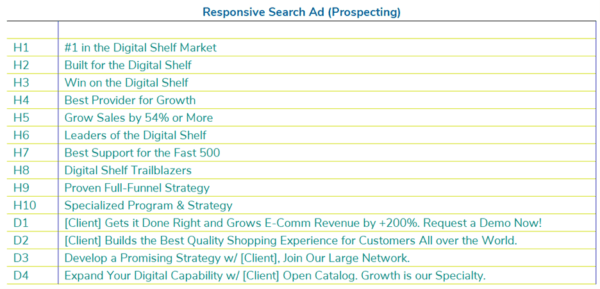
Notice that our prospecting ad copy had eye-catching numbers throughout the headlines and descriptions, while also establishing industry leadership.
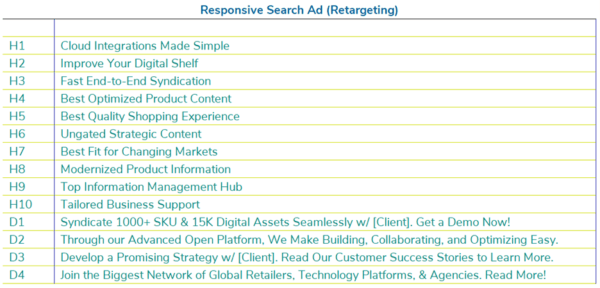
In our remarketing ad copy, we took a different approach, emphasizing exclusive ungated content and leveraging our strategic partnerships. Remarketing ads should provide enticing incentives for those returning to the website.
Remarketing campaigns are hard work, but the quality of customers and quantity of converters makes it worth it!
Take Your Remarketing Efforts to the Next Level
Thanks for making it to the end of our blog post! Ready to launch your next killer remarketing strategy or do you need some additional support? Learn how our team of experts approach remarketing and contact (un)Common Logic to help you scale your remarketing efforts! We can’t wait to partner with you on your next digital marketing endeavors.
Is your digital marketing strategy focused only on top of funnel expansion? How do you move from increasing awareness to increased conversions? Have you considered remarketing? At (un)Common Logic, our expert B2B SaaS marketing services, including retargeting strategies, grew one of our B2B SaaS client’s conversion rate by 288%, conversion volume by 828%, and reduced cost per lead by 67% in three months. On average, 79% of marketing leads don’t convert into sales due to lack of nurturing processes. Remember, it’s not only about increasing awareness, but also the attention you give your audience once they're aware of your business and offerings.
Once you’ve decided to include remarketing, you need to consider:
- Which platform(s) to use
- How to track your audience so you can remarket to the right prospects
- What list(s) you want to use for remarketing purposes
Keep reading for (un)Common Logic’s tips and tricks for creating a successful remarketing campaign.
What is the Purpose of Remarketing?
Before we can deep-dive into strategy, we must break down the remarketing basics and why it is so important.

Let’s take a look at your basic marketing funnel. The awareness stage is crucial for brand recognition and expansion, but does not guarantee a conversion, especially if you’re in a competitive space. Think of window shopping: you see a jacket in a store with a cool logo, but you don’t currently need a jacket, so you walk away (awareness). Then, as you're driving around, you see a billboard with the same jacket worn by a celebrity at a discounted price (research), so now you might think about going back to buy the jacket. When heading back to the store, you pass by a similar jacket but with a different logo (compare), but you still want to check out the original store before you buy a jacket. Finally, you get back to the original shop and see that discount sign again making it cheaper than the other jacket (consider), this ultimately makes you buy the jacket (purchase).
The billboard, the celebrity, and the discount were all remarketing tactics that succeeded in pushing a purchase. Remarketing is one of the best ways to close sales that didn’t happen the first time.
What is Required for Successful Remarketing Campaigns?
A solid foundation for the best remarketing strategy requires proper tag installation and a strong customer match list. Keep reading to learn more about requirements and parameters for tags and lists.
What Platforms Can Utilize Remarketing/Retargeting?
Google and Facebook (Meta) are the most used platforms for remarketing ads due to their ease in implementation and diversity in applications.
How Do You Implement Remarketing in Google Ads?
Tag-You’re-It
Determine what landing pages are directly related to your marketing objectives, for example, the landing page(s) could be a dedicated PPC landing page or white paper. These are the pages you would want to set up your ad campaign around.
It is crucial that your remarketing tag is installed correctly on all website pages to ensure that the right visitor traffic is being captured to strengthen your remarketing campaign. To create a Google Ads Remarketing Tag, you will first need to have Google Tag Manager (GTM) account set up. After that is completed, follow these steps to set up a Google Ads Remarketing Tag. This Google developer guide has instructions on how to set up remarketing tags in Google Analytics.
Is there a benefit to using one or the other? The answer is dependent on the data needs of the account. If you’re looking to go in-depth with specific website conversion actions, such as video views or website bounce rate and user traffic, we would recommend installing Google Analytics’ remarketing tag. However, if you are looking to retarget one audience group, we would recommend Google Ads’ remarketing tag.
Using a First Party Customer Match List to Remarket in Google
A remarketing list is a list made up of customer emails in addition to customers' first and last names. Google search network and display requires a 1000+ audience list to be big enough to serve ads. When you upload your list to Google Ads, the system will flag if the list is large enough to use. This process should take about 1 - 24 hours to scan depending on the size.
How Do You Implement Remarketing in Facebook Ads?
To set up your Facebook (Meta) remarketing ads, leverage Facebook’s (Meta’s) retargeting pixel and your remarketing lists.
Pixel Perfect
Similar to Google, Facebook (Meta) has a code that you or your website developer can install on your website. This tag tracks users’ engagement with your brand’s Facebook ads and website through clicks, add to carts, or pageviews. After this tag is set up, Facebook (Meta) will begin building your “lookalike” audiences – audiences who have similar interests or behaviors as your current website visitors – and can also dynamically serve ads to those who already visited your website.
Don’t Forget Those Minimums
Prepare a list of at least 100 people to target on Facebook (Meta). Again, this list can come from a variety of sources: newsletter sign-ups, sweepstake sign-ups, or whitepaper downloads. According to Facebook, this list will be secure and will NOT be shared with other businesses unless you grant access.
Strategies and Tactics for Effective Remarketing
Now that we’ve gone over the basic set ups and functionality, let’s deep-dive into the details for the best remarketing strategies.
1. Remarketing lists can be built from almost anything.
Did you have a recent giveaway? Did you have a newsletter or whitepaper download? Did you have a slew of purchasers? Did you have a virtual webinar? Remarketing lists can be made from all the above - as long as you have the visitors’ email, first and last name, that’s all you need. Depending on your needs, (un)Common Logic recommends retargeting audiences that have completed lower funnel actions such as PDF downloads on a specific page. This ensures higher quality conversions versus those who only complete email form fills from a pop-up or newsletter. Just make sure that you abide by the user minimums listed in the previous sections.
2. Be intentional. Retarget specific URL visits to guarantee quality.
Website visitors are great but can be a hit or a miss depending on the type of traffic you were getting on your website. For example, if you target very broad affinity audiences on Google and you retarget just site visitors, you might be wasting ad spend on users that are not very interested in your services. However, if you target high intent pages such as video demos (get granular and target 7% video watched) or case study pages, this ensures that your remarketing ads are being served to a relevant audience. We’ve developed successful B2B remarketing campaigns that target previous webinar attendees and PDF downloaders. Our cybersecurity client had a 185% higher conversion rate and a 20% lower bounce rate with returning visitors than new visitors.


3. Abandoned Carts? Don’t be discouraged!
If your product has a long buying cycle, remarketing ads are your secret weapon. Make sure that these folks are being targeted for upcoming promotions or new launches. They clearly have displayed interest in your product but just need that final push to complete a purchase.
4. You’ve correctly tagged everything and grown your lists, great, but that’s not all!
Remarketing expands much farther than tags and lists. You can’t forget your ad copy! WIIFM (what’s in it for me?) is the main driver for any converter. Don’t serve your customers with the same images that you gave them on the initial interaction, you want something more eye catching. For example, if you’re a B2B client that used a generic lifestyle image for your prospecting display ad, the remarketing ad should contain sneak peeks of your platform’s user interface. You change how you speak when talking to a close friend or someone special; think of your returning visitor as someone special! Update your ads with more niche value props to help solidify that consideration, this can be done through special discounts or exclusive access. Here's an example of how we modified our ad copy for initial prospecting vs retargeting for a B2B client focused on managing product information:

Notice that our prospecting ad copy had eye-catching numbers throughout the headlines and descriptions, while also establishing industry leadership.

In our remarketing ad copy, we took a different approach, emphasizing exclusive ungated content and leveraging our strategic partnerships. Remarketing ads should provide enticing incentives for those returning to the website.
Remarketing campaigns are hard work, but the quality of customers and quantity of converters makes it worth it!
Take Your Remarketing Efforts to the Next Level
Thanks for making it to the end of our blog post! Ready to launch your next killer remarketing strategy or do you need some additional support? Learn how our team of experts approach remarketing and contact (un)Common Logic to help you scale your remarketing efforts! We can’t wait to partner with you on your next digital marketing endeavors.

